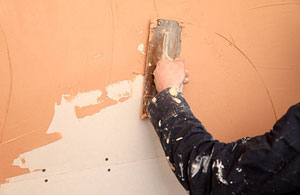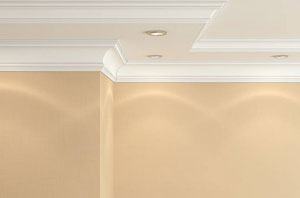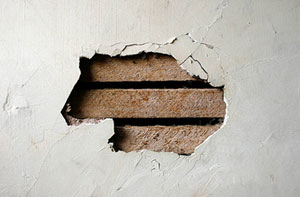Street Plasterers: When your home in Street needs some plastering work doing, it doesn't matter whether big or small, you'll be wanting to locate a qualified and professional plasterer to do the job with much care and attention. Plastering can take years of practise to perfect, so you really should not attempt to do it by yourself.
Even relatively minor home restoration assignments can create the need for some plastering. It could be plaster repair in preparation for tiling, plaster skimming some dry lining, fitting coving or decorative mouldings before decorating or plastering over an old artexed ceiling. Do not however imagine that those are the only plastering jobs that may be needed, since there are many more possibilities.

Looking at a portfolio of proficiently accomplished work is an easy way to assess the quality of any potential Street plasterers, you need to identify somebody who knows what they're up to. You do not want to get stuck with a team of "cowboys" messing up your plastering. It is really difficult to resolve poor quality plastering after the event, therefore it needs to be done right from the outset.
You will soon become aware of any imperfections as soon as a coat or two of emulsion has gone onto the newly plastered wall. When viewed in bright sunlight, even more imperfections will show up on any uneven surfaces. So, be sure you only consider experienced plasterers in Street.
It is always good to keep in mind that plaster should be smooth and flat, since it's just a base upon which other materials and products are applied. Slight blemishes and cracking can be filled and sanded later with very few issues, but uneven plaster is hard to conceal. An irregular plastered area could cause serious problems with the decorating of ceilings and walls, the fitting of architraves, the installation of kitchen units and the tiling of wall surfaces.

With plastering it is preferable to get a polished finish, right from the trowel, and this is what you can usually expect from experienced Street plasterers. You can recognise when plastering has been carried out by an expert, because a brief rub down is all that is required and no heavy sanding is necessary. If the finished plastering needs strenuous sanding, you know that it hasn't been done correctly. If you hear the loud buzz of orbital sanders, you need to do a thorough quality assessment.

Nowadays, a common reason to call in a plasterer is to cover an old artexed ceiling. Hundreds of properties in Street had ceilings which were coated with artex during the 70's and 80's, when it was at its height of popularity. So as to get your ceilings looking sleek and modern once again, your Street plasterer will be happy to cover them up with a smooth new finish. If the contrary is the case, then many plasterers will bring that old style back again by slapping on a coat of artex.
DIY Plastering Street: While it's always preferable to bring in a professional plasterer in Street when you have plastering work that should be done in your home or business premises, it is always possible to have a go at doing it yourself if you're reasonably good at DIY, and have the self-confidence to try. Choosing an area that's already got an inaccurately plastered finish is a good idea to begin with, so that your amateur plastering amateurish efforts can only make it better. An out-of-sight area or a spare bedroom would be the perfect place to start. This is going to be less stressful for you, and allow you to spend a bit of time trying out your newly acquired skills. You will most likely make a bit of a mess of it on the first couple of attempts, but you don't have to fret because it is possible to re-skim a wall surface as many times as you wish.

If you do not want to go to the lengths of signing up for an actual plastering course, you might be able to get some decent tips and advice by watching and following YouTube tutorials, although it's not always quite so simple as it's made to look in those videos. Plastering is a "hands on" activity and the more you practice the more adroit you get. You could even think up some of your own solutions for accomplishing a flawless finish, then again the time-tested ways are generally the best. The more often you do it the more confident you'll get, and at the end of the day - plastering is mostly about self-confidence. You can take on some more challenging plastering projects as soon as you have mastered the art to a decent level. If you do mess things up, you've still got the option of bringing in a competent Street plasterer to put it all right.
Plastering services can be accessed in the Street area, as well as in: Stone Hill, Compton Dundon, Baltonsborough, Beckery, Shapwick, Glastonbury, Walton, Ashcott, Meare, Butleigh Wootton, High Ham, Northover, West Pennard, Overleigh, Lower Leigh, Butleigh, plus places with postcodes like: BA16 0NP, BA16 0AZ, BA16 0FE, BA16 0FN, BA16 0BW, BA16 0DB, BA16 0HT, BA16 0LH, BA16 0GG, and BA16 0GP. Plastering contractors from Street will typically have the telephone code 01458 and the postcode BA16. This is naturally something that you can verify if you favour using a local expert in plastering. Street property owners are able to utilise these and numerous other related services. Clicking on the "quote" form or banner will allow you to acquire plastering details for your area. Or you can CLICK HERE if you prefer.
Plaster Patching Street

Cracked or damaged plaster is a regular problem, especially with older properties in Street or those which have recently gone through construction work or home improvements. Since the plaster finish is a key part of your wall's surface, you need to keep it in good condition so it can be decorated and kept looking neat. There is nothing worse than having cracked plasterwork, or areas that are untidy or sloppily repaired with Polyfilla. A professional Street plasterer will pretty quickly have your walls looking great once more, and you'll be able to complete your decorating and get them looking in pristine condition once again. Problems such as dampness, settlement, shrinking, accidental damage and vibration can cause issues with plaster walls and ceilings. Ahead of carrying out any patching up it's essential to address any underlying problems, since damage will probably reoccur if they are not taken care of beforehand.
Dry Lining (Plasterboarding) Street

There are several home refurbishment projects that will require dry lining (plasterboarding) to be carried out, and a few Street plasterers will be happy to do this for you. A procedure that produces a stable wall surface which does not have to be plastered, plasterboard can be affixed to a brick or masonry surface, metal Gypframe or a wood studding. Although in some situations the plasterboard itself may be decorated (with some extra preparation), an exceptionally smooth, hard surface is produced by applying a final skim of finishing plaster. In regards to fittings, when attaching plasterboard to wooden joists or studding, nails or drywall screws are used, when fixing to a metal framework self-drilling, self tapping (Jack-Point screws) are used and when fixing to a brick or masonry wall the "dot and dab" method is used. (Tags: Dry Lining Street, Plasterboarding Street, Dry Liners Street)
Plaster

Employed for decorating and protecting the walls and ceilings of buildings, plaster is a material that's been in use since the days of the ancient Egyptians. What most of us call "plaster" in the UK is normally understood to be the stuff that's used for covering the inner rooms of structures and homes, while that which is used on outside walls is referred to as "render" or "rendering". The plaster mixture itself can contain various ingredients but most commonly consist of either lime, gypsum, or cement. All of these mixes basically work in the same way, but serve different purposes. Plaster is is produced in powdered form and when needed, is mixed with water to make a stiff but easily workable paste just before application. The mixing of the water and the plaster powder causes a reaction, and heat is generated through crystallization, making the paste set. For buying plaster products you can head over to B&Q, British Gypsum, Screwfix, Travis and Perkins or Wickes. (Tags: Plastering Street, Plaster Street, Render Street)
Rendering
Rendering is a widely-used technique to improve the exterior of a property, offering both functional and aesthetic benefits. It consists of applying a protective layer, typically made of cement, lime, or acrylic, to the outer walls. This layer acts as a barrier against the elements, protecting against rain, wind, and frost. Moreover, it gives your home a fresh, modern look, with various finishes and colours to choose from to fit your style. Whether you're renovating an older property or enhancing a newer one, rendering is a versatile option that merges practicality with visual appeal.

Rendering is not only about cosmetic enhancements; it can also elevate the overall performance of your home. Many of the modern render systems available today feature insulating properties, helping to keep your interiors warm in winter and cool in summer. This added insulation not only increases comfort but can also result in lower energy bills over time. Moreover, rendering effectively seals cracks and imperfections in the walls, which diminishes the risk of dampness or water ingress that could lead to expensive repairs in the future. It's a long-lasting solution that preserves and protects your property in Street.
To get the best possible results, it's worth it to seek out professional advice regarding the most appropriate materials and methods for your property. Professionals can ensure an accurate application, resulting in a polished finish that is durable and stands the test of time. They will also advise you about maintenance requirements, ensuring that your rendered walls are kept in top condition for years. From finding the ideal texture and colour to choosing systems that are suited to your local climate, their expertise is truly invaluable. With the right approach, rendering can effectively transform your home's exterior in Street, while also adding insulation, protection, and value. (Tags: Rendering Street).
Artexing Street

Especially popular during the 70's and 80's, artex has long been a good way to add an ornamental finish to a ceiling, as well as to cover over uneven surfaces and cracks. In the past, there were so many tradespeople carrying out artexing it was easy to locate someone providing this sort of service in Street. These days however, tracking down a plasterer who is prepared to do artexing is not quite as simple. No doubt the huge variety of styles and designs was the thing that made it so widely loved, and everyone appeared to have their particular favourite, be it criss-cross, medusa, broken leather, swirl, hook & line, scroll, basket, pairs, stippled, circles or bark. Artex patterns were available to suit any personal preference or taste. You can obviously still get all of these styles these days, just find a plasterer in Street who continually executes this type of work, and not one who'll simply "give it a try", by doing this you can ensure that you'll get a decent job made of it. With that said, it should be mentioned that artex is quite difficult to patch or repair and it is probably because of this that its use waned.
Polished Plaster Street

Polished plaster is largely the term given to contemporary versions of traditional Italian plaster finishes which have been used to good effect for many centuries. Describing anything from rugged textured plasters to very highly polished Lucidato, Marmorino and Venetian plasters, the expression "Polished Plaster" in fact describes a variety of superior plaster finishes. Implemented mostly on inside ceilings and walls, polished plaster is intended to deliver a surface finish that appears like polished marble, limestone or travertine. Polished plaster provides a feeling of depth by means of natural variations in shade whilst being sleek and smooth to touch. By the combining of these different forms of plaster products it is possible to develop distinct bespoke finishes which can be employed to good effect. By the use of natural or synthetic colourants, eye-catching colours or tints can be given to the polished plaster finish. If you need to achieve "marbling" effects in your plaster, or completely unique colours or designs that don't exist in nature, the ability to add a tint to Venetian plaster is particularly handy. To find out more regarding polished plaster, take a look at Wikipedia (HERE). Or head on over to Armourcoat (Tags: Marbled Plaster Street, Polished Plastering Street, Venetian Plaster Street, Polished Plaster Street)
A Plasterer's Tools
When plastering work needs to be done in Street, most tradespeople and DIYers will find that they do not have all the tools which are necessary to do a decent job. Which is why in the majority of cases a certified plasterer will be needed for this sort of work. Listed here are just a handful of the tools that a professional plasterer will use:
- Corner Trowel
- Plaster Mixing Paddle
- Plaster Buckets & Pan
- Plasterer's Hawk
- Plasterer's Trowel
- Finishing Trowel
- Feather Edge
- Plasterboard Carrier
- Plastering Rule
- Edging Trowel
- Jointing & Taping Knives
- Drywall Rasp
Pebble Dashing

A method which is frequently used to protect and decorate the outside of properties, pebble dash isn't everybody's cup of tea in Street. Plasterers will usually do this kind of work for you, although there are pebbledashing specialists out there. Suitable for both renovated and new homes, pebble dashing generally consists of a couple of layers of a base coat made of sand and lime onto which small gravel or pebbles are firmly pressed to form a decorative, maintenance free and robust finish. (Tags: Pebble Dashing Street, Pebble Dash Street, Pebble Dash Removal Street, Pebble Dashers Street)
Skimming and Re-Skimming

When you have damaged plaster surfaces, artex that needs covering or new dry lining, you will need a tradesman to re-skim or skim with with a finishing plaster. Plasterers are often asked to carry out this kind of task. Existing plasterwork can easily be damaged during home refurbishments, and new plasterboarded wall surfaces could be put in. Those imperfect surfaces can be transformed into smooth, glass-like finishes by a specialist who is skilled in this technique. After a few days of drying out, you'll be able to decorate over the new plaster area. A beautifully flat and fault-free surface should be the result you finish up with.(Tags: Skimming Street, Re-Skimming Street, Plaster Skimming Street)
Acoustic Plastering Street
Struggling with bothersome echoes or finding it hard to hear conversations in a noisy room? Acoustic plastering could be the answer. This innovative technique tackles sound issues by utilising specialist plaster that absorbs sound waves. Unlike its standard counterpart, acoustic plaster incorporates fibres or aggregates that disrupt sound energy, reducing echo and creating a more comfortable listening environment.
Fortunately, modern acoustic plaster systems are perfectly safe, having ditched the harmful asbestos present in historical versions. These systems typically incorporate two layers. The initial layer, often constructed from mineral wool or a specialised blown-glass granulate, acts as the bedrock for sound absorption. Finishing coats are then applied on top, delivering a smooth and visually appealing finish while further deadening sound.
Ditch the visible grids and explore the world of acoustic plaster! It offers several advantages over conventional soundproofing methods. Firstly, it delivers a seamless, unbroken finish, unlike acoustic panels. Secondly, its flexible properties allow for application on curved surfaces and intricate shapes, giving you more design freedom in your space. And to top it all off, some acoustic plaster systems can even integrate with cooling and heating systems, making them a truly versatile choice for a variety of rooms. (5265 - Acoustic Plastering Street)
Plastering Tasks Street

Street plastering specialists can usually help with fireplace niches, speed skimming Street, rendering with sand and cement, damaged plaster repairs, hard walling Street, external plastering, lime plastering, blown plaster Street, drywall finishing, repairing holes in walls and ceilings, plasterboard skimming, lay in grid suspended ceilings, polished plastering, bonding in Street, cornices and ceiling roses, screeding before tiling, artex testing Street, ceiling overboarding Street, stucco plaster in Street, coloured K Rend, ceramic tiling, pitted plastering, sand and cement screeds, plastering archways Street, floor levelling Street, plastering quotations Street, Venetian polish plaster, lime hemp plastering, insurance work, lime rendering, skimming plaster walls, the plastering of ceilings, traditional & modern plastering Street, dry dashing in Street, damp proofing services and other plastering work in Street, Somerset. These are just some of the activities that are undertaken by local plasterers. Street specialists will inform you of their full range of plastering services.
Plasterers Near Street
Also find: Ashcott plasterers, Overleigh plasterers, Shapwick plasterers, Baltonsborough plasterers, Lower Leigh plasterers, Compton Dundon plasterers, Glastonbury plasterers, High Ham plasterers, Meare plasterers, West Pennard plasterers, Walton plasterers, Stone Hill plasterers, Northover plasterers, Butleigh plasterers, Butleigh Wootton plasterers, Beckery plasterers and more. Practically all of these areas are served by local plastering specialists. Householders in these localities can get plastering price quotes by clicking here.
Street Plastering Services
- Street Plastering
- Street Domestic Plastering
- Street Plaster Overskimming
- Street Cornice Installation
- Street Ceiling Replacements
- Street Plasterboarding
- Street Plasterers
- Street Artexing
- Street Plasterer
- Street Plaster Patching
- Street External Rendering
- Street Partitioning
- Street Plaster Repairs
- Street Soundproofing
Other Useful Trades in Street Somerset

Of course, whenever you're doing home improvements in Street, Somerset, you'll probably need all sorts of different tradesmen and apart from plasterers in Street, Somerset, you might also need builders in Street, waste removal in Street, electricians in Street, dry lining in Street, painters and decorators in Street, artexers in Street, decorative cornicing in Street, plasterboarders in Street, coving fitters in Street, external wall insulation in Street, carpenters in Street, pebble dashers in Street, renderers in Street, domestic cleaners in Street, screeders in Street, and other different Street tradesmen.
 Plasterers Street
Plasterers Street Plastering Near Street
Plastering Near Street Plasterer Street
Plasterer StreetMore: Commercial Plastering, Plasterers, Plastering Firms, Plastering Repair, Internal Plastering, Plaster Skimming, Plastering Specialists, Domestic Plastering, Cheap Plastering, Plastering Companies, Plastering Firms, Residential Plastering, Pebble Dashing, Plastering Specialists, Plastering Services, Plasterer, Rendering, Plastering, Plasterers, Plaster Repairs, Plaster Skimming, Internal Plastering, Plastering Contractors, Plaster Repair, Plastering Contractors, Plaster Patching, Patch Plastering, Plasterer, Plasterers, Plastering Repairs, Plastering Contractors, Plastering Repair, Plasterer.
To read local information relating to Street, Somerset look here
Plasterers in BA16 area, 01458.
Decorative Plastering Street - Artexing Street - Plastering Street - Patch Plastering Street - Plasterers Street - Screeding Street - Plasterer Street - Cheap Plasterer Street - Rendering Street





